Tethered Oral Tissues (TOTS) FAQs
Frequently Asked Questions about Tethered Oral Tissues in Belpre, OH
What are TOTS?
What is a tongue tie?
What is a lip tie?
What is a buccal tie?
What are the signs and symptoms of TOTS?
I only recently heard of TOTS, are frenectomies just a money-making fad?
My baby’s tongue looks normal, but they have a lot of symptoms. Could they still have a tongue tie?
Is every patient that requests a TOTS examination treated?
Will my child grow out of TOTS?
Can I wait until my baby is older to get the release performed?
Can TOTS cause speech problems?
How are TOTS diagnosed?
Why seek treatment from a dentist?
What does the TOTS release process look like?
What is bodywork?
Why a laser?
Will general anesthesia be required for the release?
Will a tongue-tie release be painful for my baby?
Do bottle-fed babies suffer from TOTS too?
Why should I choose Belpre Dental Studio and Dr. Huffman to evaluate/treat TOTS?
What is the payment process?
Will I get hit with unexpected or hidden charges in the months following the procedure?
How is insurance handled?
TOTS stands for Tethered Oral Tissues. TOTS is the collective term for tongue, lip, and cheek ties. It describes a congenital condition in which the bands of tissues that connect these oral structures to the rest of the mouth are keeping them from moving and functioning normally. This condition negatively impacts the vagal nerves which control your parasympathetic nervous system. This explains why TOTS can cause a wide range of symptoms throughout your body for the duration of your life.
A tongue tie is when the thin membrane under the tongue (lingual frenulum) is too short, too tight, or both and restricts the movement of the tongue. For babies, tongue ties affect their ability to move their tongues freely and thus can affect their ability to swallow and/or breast or bottle feed properly. It can also cause intense pain and decreased milk supply over time for nursing mothers. Over time, the issues caused by a tongue tie change as you engage in a broader range of activities like eating solid foods and speaking.
A lip tie is an abnormally tight membrane (labial frenulum) attaching the lip to the upper or lower gums. Babies with a lip tie often have trouble flanging their lips to feed and can’t create a proper seal at the breast or bottle. This can cause them to take in excess air during feeding, which often makes these babies gassy and fussy. It can be the root cause of colic in many babies.
Buccal or cheek ties are abnormally tight membranes (frenulum) attaching the cheeks to the gums. This can impair the function of lips and cheeks which are needed for proper feeding.
What are the signs and symptoms of TOTS?
* Each case is different. Patients rarely have every symptom. Typically, patients have their own unique combination of symptoms. Below is a brief list of common symptoms. Please find our full list of symptoms here. Our lists of common symptoms are categorized by age into groups including infants, nursing mothers, toddlers & children, and teens & adults.
Infants may have difficulty latching onto the bottle or breast, make clicking or smacking sounds while eating, have reflux or colic symptoms, and experience poor weight gain. One of Dr. Huffman’s most memorable cases involved an infant diagnosed with failure to thrive who gained almost a pound in the week following the procedure without any other treatments.
Nursing mothers may experience painful breastfeeding, low milk supply, and flattened or damaged nipples after breastfeeding.
Toddlers and children may have speech delays or problems, struggle with solid foods, have breathing issues such as snoring, exhibit hyperactivity, and gas.
Teens and adults may suffer from TMJ disorders, clench or grind their teeth, have frequent headaches or migraines, snore or suffer from sleep apnea, or have acid reflux. A 25-year-old patient of Dr. Huffman’s reported being able to touch her toes for the first time in her life on the same day after her TOTS release procedure.
This is relevant because the lingual frenulum (tongue tie) is fascia, not muscle. Fascia is a thin casing of stringy connective tissue that holds our organs, blood vessels, bones, and nerve fibers in place in our body. In the diagram below, you can see the Deep Front Line (DFL), our myofascial ‘core’ which runs almost the entire length of our body.

After looking at the above diagram, it is easy to see how a tongue tie can impact your breathing, flexibility, posture, and walking.
If you think you or a loved one may be suffering from TOTS, please review our full list of signs and symptoms as well as schedule a consultation with Dr. Huffman.
I only recently heard of TOTS, are frenectomies just a money-making fad?
No, they are not a fad of the 21st century. TOTS is not a new diagnosis and frenectomies are not a new procedure. Historically, frenectomies were done by doctors and midwives to correct ties and make breastfeeding easier and more comfortable for mother and baby. In the 20th century, formula became popular and was encouraged by medical professionals. As a result, any mother struggling to breastfeed was directed to switch to bottle feeding. While TOTS can also cause issues with bottle feeding, they are less obvious since the mothers’ symptoms are not present like they are for breastfeeding.
Additionally, there was little understanding of how untreated TOTS could cause ongoing issues. Because of this, tongue ties appeared to “go away”. In recent years, breastfeeding rates have been climbing which has brought awareness back to TOTS. Along with this, a great deal of research has been conducted globally to better understand TOTS and their lifelong implications. According to the Mayo Clinic, up to 10% of all infants are born with a tongue tie.
My baby’s tongue looks “normal”, but he/she has a lot of symptoms. Could he/she still have a tongue tie?
Sometimes tongue ties are easy to spot with an untrained eye. In Figure 1 below we can see a Kotlow Class IV anterior tongue tie. The white arrow points to the frenulum which has string-like appearance. Posterior tongue ties are more difficult to diagnose due to their position beneath the mucous membranes at the bottom of the mouth. Only medical professionals with specialized training can diagnose them. In Figure 2 below we can see an example of a posterior tongue tie. Keep in mind that TOTS must be assessed and diagnosed based upon function, meaning what they look like is less important than how they can move and what symptoms are present. A posterior tie may look very similar to a normal, well-functioning tongue. These are sometimes called “hidden” tongue ties.
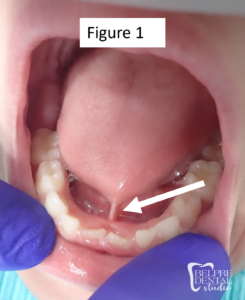

Is every patient that requests a TOTS examination treated?
No. Dr. Huffman rules out a TOTS diagnosis for some patients. For a few others, there are compelling reasons to delay treatment.
Will my child grow out of TOTS?
No, TOTS are not something that we can grow out of although the symptoms will change over time. Many tongue-tied children are not able to consume enough nourishment to follow normal growth and weight gain patterns. In severe cases, this can be the root cause of failure to thrive. Ties may also affect breathing and can cause sleep issues, snoring, mouth breathing just to name a few. In older children, it can present as delayed speech development and hyperactivity along with a wide variety of other symptoms. Adults with ties may experience headaches and migraines, sleep apnea, reflux, and much more. Find the full list of signs and symptoms here.
Check out the testimony below from one of Dr. Huffman’s adult TOTS patients.

Can I wait until my baby is older to get the release performed?
Yes, however, there are some notable downsides to delaying treatment.
- The benefits to having TOTS treatment done at a young age are: It allows your baby to experience relief of symptoms sooner which could include getting adequate nutrition, relieving reflux, eliminating gas and colic, and being able to breathe unobstructed, just to name a few!
- Treatment is less traumatic for infants. They are less resistant to being handled and enjoy being swaddled. Infants have not developed fears of doctors, strangers, or medical settings. Additionally, they will not remember the procedure.
- The longer you wait the more habits and muscle memory have formed, i.e., moving the tongue or lips in certain ways to eat and make sounds while hindered by tethered oral tissues. Relearning proper, unencumbered movements is easier at an early age. If you wait, it will likely take longer to correct and require a more involved process including pre-treatment bodywork with a specially trained chiropractor or Doctor of Osteopathic and Manipulative Medicine.
- It is more difficult to get older children to cooperate with exercises/stretches post-procedure. These are vital to keeping the tissues from re-attaching in the same place.
- If speech issues develop later, speech therapy may be required.
- Some toddlers and preschoolers are too combative to safely treat without general anesthesia which carries significant risks. The other alternative is to wait even longer while on-going symptoms take their toll.
Can TOTS cause speech problems?
Yes! Speech problems are a common symptom for children with untreated TOTS. Some common speech-related symptoms are:
- Speech difficult to understand
- Trouble with certain sounds
- Speech delay
- Stuttering
- “Baby talk”
- Mumbling or speaking softly
Speech development requires the collaboration of the tongue, lips, jaw, and palate to function together to create sounds. TOTS can restrict movement and create problems with sound articulation. Challenging sounds often include: D, L, R, S, T, Th, and Z. For these sounds, the tongue needs to touch the upper palate or teeth.
It is important to note the many impacts of speech delays including social, academic, and emotional. Think about how frustrating it is when someone on the other end of the phone can’t understand what you are saying! When children can pronounce sounds and words to communicate with others, it empowers and inspires them to continue developing their communication skills. Communication is essential to forming friendships, support systems, and emotional bonds.
If your child is having problems with speech, TOTS are one possible cause. Dr. Huffman recommends coming to him for an evaluation. Since TOTS can be treated fairly easily, it makes sense to rule out tongue or lip tie as the cause of the speech issues. Dr. Huffman also recommends working with a speech therapist.
Take a look at Dr. Huffman’s patient that was struggling with a speech problem!
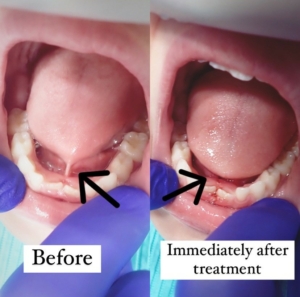
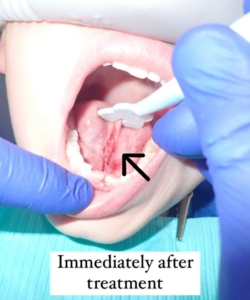
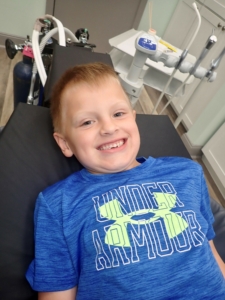
Patient/ Parent Concerns: 6-year-old patient has been in speech therapy for three years with little improvement. The speech therapist recommended the release to patient’s mother who found Dr. Huffman online.
Doctor Diagnosis: Patient suffering from a severe tongue tie which was restricting movement required to enunciate certain sounds and causing separation of the lower front teeth. This tongue tie was one of the most severe that Dr. Huffman has treated. Child patient also showing signs of anxiety and fear concerning the upcoming release procedure.
Treatment: Laser frenectomy treatment by Dr. Huffman which released the frenulum allowing the muscles of the tongue to move more freely. Nitrous Oxide (laughing gas) was used as a comfort measure during the procedure to alleviate anxiety.
*Note: The after photo was taken immediately after the release. The lack of blood is due to the cauterization by the laser which is a wonderful advantage to laser releases over scissor/ scalpel releases.
Outcome: Patient continued to work with speech therapist to learn how to use his new tongue mobility to make previously challenging sounds. 3 weeks post release, patient was able say the “L” sound for the first time.
TOTS are diagnosed through a simple visual and manual examination of the oral tissues by Dr. Stephen A. Huffman or another provider that has received this highly specialized training on TOTS. Tongue, lip, and cheek ties are diagnosed based upon function, meaning what they look like is less important than how they can move.
Why seek treatment from a dentist?
Treatment of the condition requires highly specialized knowledge of the oral structures and functions. Dentists, also called a Doctor of Dental Surgery or DDS, are entirely focused on just that which is why it has become a subspecialty for dentists. That being said, dentists still require in-depth training to be qualified to treat TOTS.
In the medical field today, surgeons are highly specialized. There are neurosurgeons, hand surgeons, plastic surgeons, and so on. Each subspecialty involves in-depth training in both diagnostic and surgical techniques in order to produce the best outcomes for patients. The same is true for TOTS.
Take a look at Dr. Huffman’s patient that required retreatment after initial treatment by a professional that was not specially trained in TOTS!
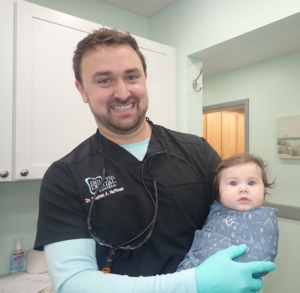
Patient/ Parent Concerns: Patient is 5 months old. When she was less than 1 month old, tongue tie was released by an ENT using scissors, but the provider did not instruct parents to perform any stretches, so it reattached.
Doctor Diagnosis: When presented for retreatment, patient had Kotlow Class 3 tongue tie and lip ties.
Treatment: Laser lingual and labial frenectomy by Dr. Huffman to release ties. Exercises to prevent reattachment along with complete post-surgical instructions provided.
Outcome: 3 weeks later, the patient’s latch has greatly improved, can now stick out her tongue, and her lip no longer curls under when feeding.
What does the TOTS release process look like?
- The process first begins with discussing the concerns and symptoms with the parents and/or patient. Then, function and anatomy are assessed. The way a tie looks is much less important than the way it functions and the symptoms that the patient and/or mother are experiencing.
- For patients diagnosed with one or more ties, the next step is reviewing the treatment plan. The release, which only takes a couple minutes, is typically performed immediately.
- Dr. Huffman uses a laser which minimizes bleeding and discomfort, speeds healing, and allows clear visibility of the tissues which is necessary to achieve a full release.
- After the release, staff escorts mother and patient to our private nursing/feeding room so they can achieve a comfortable latch and feeding before discharge. Our female staff provides support as needed.
- Finally, we review the post-op instructions and exercises and provide a referral for bodywork to one of our community partners. The exercises are vitally important to prevent re-attachment of the ties. Bodywork helps to overcome muscle memory by retraining the body to utilize its increased range of motion in the oral structures. It also helps by relieving muscle tension caused by TOTS.
- We conduct follow-up assessments by phone around 1-2 days and 14 days post-surgically. We inquire about the healing process, relief of all symptoms, how the exercises and bodywork is going. Additional support is provided as needed.
Bodywork helps the body move and function optimally. It can include Osteopathic Manipulation, Chiropractic Manipulation, or Cranio-Sacral Therapy. It, along with the stretching protocol, brings the new freedom of motion to the tongue. Because tethered oral tissues (TOTS) are tied to the fascia, they impact the whole-body requiring bodywork to fully alleviate all symptoms. We will facilitate your ongoing care with the necessary referral to a bodywork practitioner with specialized TOTS training.
The use of a laser rather than a scalpel or scissors minimizes the bleeding and allows for clear visibility so the tie can be 100% released. Numbing is provided as appropriate to keep patients comfortable through the procedure.
Will general anesthesia be required for the release?
No, Dr. Huffman does not use general anesthesia which can carry serious risks especially for infants. His experience, gentle techniques, and efficient process (treatment only lasts 2-5 minutes) make general anesthesia unnecessary. Numbing is provided as appropriate to keep patients comfortable through the procedure. Nitrous oxide is also available which is safe for children and adults.
Will a tongue-tie release be painful for my baby?
A laser tongue-tie release is considered a low-pain procedure. It is uncomfortable but very quick (usually 1 minute or less per tie)! The laser’s concentrated beam of light allows Dr. Huffman to gently and precisely release the oral ties and cauterize the wound for minimal pain and bleeding.
Keep in mind that the longer you wait for treatment, the longer and potentially more painful the release will be as the fascia that makes up the tie thickens as we grow. The good news is that Dr. Huffman uses numbing and typically Nitrous Oxide (laughing gas) on children and adults. We strive to minimize pain for all patients and all procedures.
Do bottle-fed babies suffer from TOTS too?
Yes! These treatments can significantly benefit bottle-fed babies as well. By addressing tongue and lip ties, bottle-fed babies can improve their ability to latch onto the bottle more effectively, eliminate the swallowing of air, reduce feeding time, reduce effort required to swallow, and minimize discomfort. Additionally, this can help prevent issues such as gas, reflux, and colic which provides a more comfortable and satisfying feeding experience for bottle-fed infants.
Some symptoms that may occur for infants and toddlers that use bottles for all or some of their feedings are:
- Loss of suction on the bottle
- Clicking sounds when eating
- Leaking milk out the corners of mouth
- Excessive gas, burps, hiccups, or spit-up
- Reflux symptoms
- Poor weight gain
Discover How Lip and Tongue Tie Treatment Helped Hayes with Bottle Feeding: A Real Patient’s Story
Why should I choose Belpre Dental Studio and Dr. Huffman to evaluate/treat TOTS?
- We are highly responsive!! Most urgent cases are seen the same or next day.
- Our support team is well-trained and compassionate.
- Many of our staff members have had family treated for TOTS by Dr. Huffman. We have experienced the same stress and frustrations as you, making us very empathetic to yours!
- Our process is efficient with the release usually taking 1-2 minutes per tie.
- We provide continuity of care through check-in calls and follow-up appointments as needed.
- Dr. Huffman is extremely gentle. He has treated lots babies, many of them only a day or two old.
- For infants, mothers will be able to nurse or bottle-feed their babies right after the release procedure. This helps to alleviate concerns about the impact of the procedure as it relates to their baby’s recovery. Many mothers report instant relief and improvement in their children’s ability to feed which validates that treatment was needed.
- We provide patients with clear post-operative instructions for the surgical site massages and also for pain and soreness management.
- We value a team approach including lactation consultants, Doctors of Osteopathic Medicine (DOs), myofunctional therapists, midwives, speech therapists, occupational therapists, chiropractors, and pediatricians.
- Dr. Huffman received the clinical portion of his training from one of the best in the field. Dr. Greg Notestine, founding member of the International Affiliation of Tongue-tie Professionals or IATP and national leader in treating TOTS.
- Dr. Huffman is a proud member of the IATP as well as ICAP (International Consortium of Ankylofrenula Professionals) and has wide-spread support and respect from the medical community for his TOTS work.
Midwife and Founding Director of MOV Birth, Danielle Bergum says “I’ve had lots of happy moms, babies, and families receiving TOTS revisions from Belpre Dental Studio. I am still so grateful every day I can send someone locally for this after so many years of families having to drive 3+ hours for a quality revision. Managing that drive while struggling with breastfeeding used to be a daunting decision. Praise the Lord for this practice!”.
We will provide you with an estimated cost when you schedule your appointment. After the clinical examination, if the patient has a tie or ties that need to be addressed, we will determine the exact amount due for the procedure. Payment is due on the date of service. Our practice accepts most major credit cards, checks, cash, and payment plans through Care Credit!
Bear in mind, since we don’t use general anesthesia, you will enjoy considerable cost savings and not be surprised by delayed billing for that service.
Will I get hit with unexpected or hidden charges in the months following the procedure?
Our bills on the day of service are all inclusive! Unlike treatment at most hospitals, clinics, and doctor’s offices the full cost is disclosed upfront. No unexpected fees will continue to trickle in over the next 3-9 months. We believe strongly in price transparency.
While we are an out-of-network provider, we do submit claims to most private dental insurance plans on your behalf as a courtesy. 😊 Your dental insurance company will reimburse you directly for services covered and deemed medically necessary by your plan. You can find a list of dental insurances that we regularly work with on our Insurance & Financing page.
We can provide you with an insurance narrative so you can submit a claim to your medical insurance.
Our patient service coordinators are happy to answer any questions you may have about treatment or billing. Our goal is to make the process smooth and painless for all our patients!
Ready for an evaluation? Request an appointment with our TOTS Team today.
“It is very important to me that mothers and infants in the Mid-Ohio Valley have the medical support they need for diagnosing and treating tongue and lip ties and the many challenges they can create. Our ultimate goal with this treatment is to improve the quality of life of our patients, both children and adults.”
-Dr. Stephen A. Huffman
Learn more about TOTS Treatment:
Tongue & Lip Tie Treatment
Tongue & Lip Tie Gallery
Pediatric Dental Care
New Patients


